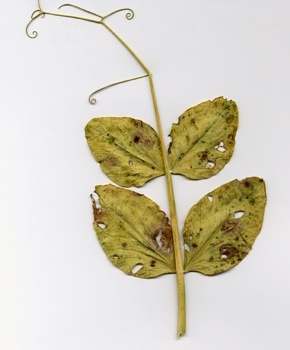Diseases
Uromyces pisi (Pers.) Schrot. and U. fabae DB. f. pisi-sativae Hiratsuka - Rust of Peas.
Systematic posicion.
Class Basidiomycetes, order Uredinales, family Pucciniaceae, genus Uromyces.Biological group.
Biotroph.Morphology and biology.
Euphorbia and infected vegetation residues are sources of the infection. The agent is not transferred by seeds. The disease appears usually at the beginning of flowering. Uromyces pisi is a dioecious fungus. Euphorbia is the intermediate host. Spermagonia and aecia develop on Euphorbia. Powdering orange-brown pustules (uredinia) containing uredospores are formed on pea leaves and stalks. Powdering dark brown telia containing teliospores appear at the end of summer. Strongly affected leaves dry up and fall down, and beans remain undeveloped. Urediniospores are unicellular, light brown, spherical, 21-25 microns in diameter, covered with sparse verruculae. Teliospores are dark-brown, unicellular, 20-31 x 14-22 microns, with short colorless falling leg and small papilla. The fungus winters on vegetation residues as teliospores and on rhizomes of Euphorbia as mycelium. U. fabae f. pisi-sativae is a monoecious fungus. The fungus passes all stages on peas. Uredinia are not powdering, being light brown. Urediniospores are rounded, single, spinose, light brown, 21-30 x 18-26 microns. Telia are not powdering, dark-brown, almost black. Teliospores are unicellular, rounded, glabrous, positioned on colorless leg, 25-40 x 18-28 microns in size. Pathogens produce several generations of urediniospores on peas. Spores are spread by means of wind.Distribution.
The disease is distributed in Europe, in Northern and South America, Asia, Australia and New Zealand. In Russia the Rust is distributed everywhere, being most nocuous in middle and southern Russia, in Western Siberia, harming also to pea crops in Byelorussia and Ukraine.Ecology.
Frequent precipitations, plentiful dews, and air temperature 20-25.C promote development of the Rust. Dry and hot weather restrains the disease development.Economic significance.
Agents of the Rust of Peas can infect Lathyrus sp. and Vicia sp. The harming activity of the Rust consists in break of physiological and biochemical processes in a plant; photosynthesis is especially reduced. The reduction of peas yield can reach 25-30%. Autumn plowing, early sowing, eradication of intermediate hosts, growing of fast-ripening varieties, and treatment of plants by fungicides reduce development of the disease.Related references:
Khokhraykov M.N., Dobrozrakova T.L., Stepanov K.M., Letova M.F. 1966. Keys to plant diseases. Leningrad: Kolos, 592 p. (in Russian).Kuprevich V.F., Ul'yanishchev V.I. 1975. Keys to rust fungi of the USSR. Part I. Minsk: Nauka i tekhnika, 336 p. (in Russian).
Makasheva, R.Kh. 1973. The pea. Leningrad: Kolos. 312 p. (in Russian).
Peresypkin V.F.1989. Agricultural phytopathology. Moscow: Agropromizdat. 480 p. (in Russian).
Shvetsova A.N., Vinogradova N.I. 1971. Diseases and pests of field cultures in Western Siberia. Omsk: Omsk Agric. Inst. 171 p. (in Russian).
© Kungurtseva O.V.


